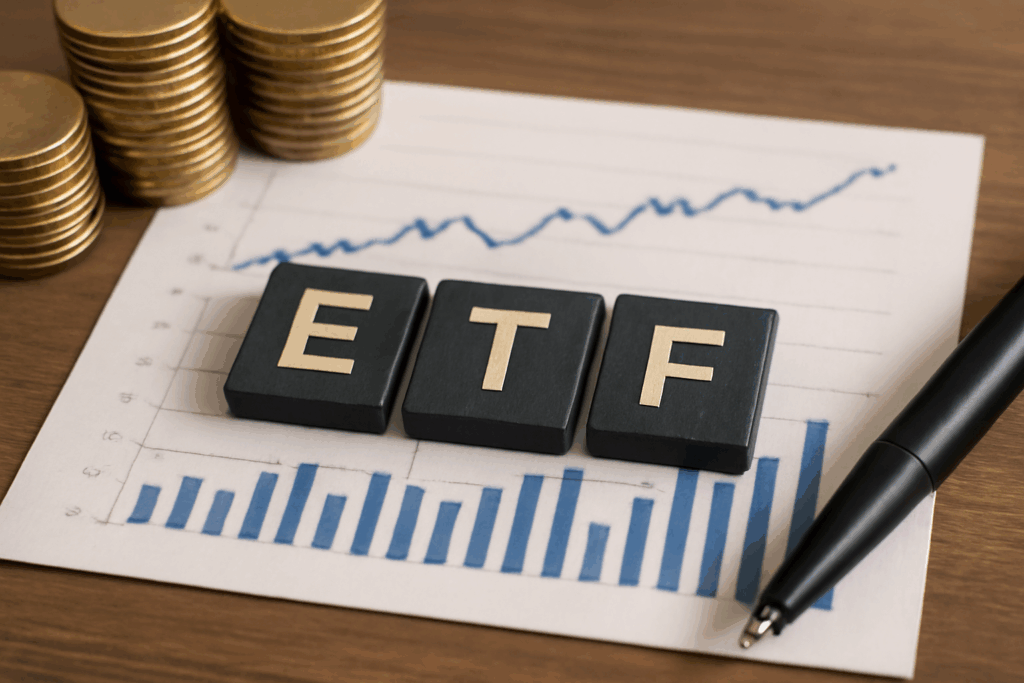If you’re looking to dive into the world of investing, you may have come across the term ETF. But what exactly is it? At its core, an ETF (Exchange-Traded Fund) is a type of investment fund that you can buy and sell on a stock exchange. Think of it as a collection of different assets like stocks, bonds, or commodities that are grouped together in one package, and you can invest in it just like any other stock.

A Simple Definition
An ETF is essentially a basket of assets. These assets can range from stocks and bonds to real estate or commodities like gold or oil. When you invest in an ETF, you’re essentially buying a piece of this basket. It allows you to own a little bit of everything inside the fund, which helps you spread your risk across different assets.
For example, imagine you buy an ETF that tracks the S&P 500 index. This ETF holds shares of the 500 largest U.S. companies. Instead of buying individual stocks from each of those companies, you can invest in a single ETF that gives you exposure to all of them.
Why Are ETFs Popular?
There are a few reasons why ETFs have become so popular among investors.
- Diversification: ETFs provide a simple way to diversify your investment. Instead of putting all your money into one stock, you can spread your risk by investing in a range of assets within the ETF. This helps reduce the chances of losing money if one particular asset performs poorly.
- Low Fees: Compared to mutual funds, ETFs tend to have lower management fees. This is because they are typically passively managed, meaning they track an index rather than being actively managed by a fund manager. This makes them an affordable option for those who want to keep their investment costs low.
- Flexibility: ETFs are traded on stock exchanges, so they can be bought and sold at any time during market hours, just like stocks. This gives investors flexibility to adjust their portfolios whenever they want, rather than being stuck with investments for long periods.
- Transparency: Most ETFs regularly disclose their holdings, so you always know exactly what you own. This level of transparency can help you make more informed investment decisions.
How Do ETFs Work?
ETFs work by pooling together money from many investors to buy a collection of assets. These assets could be stocks, bonds, or other types of investments. The goal of an ETF is to track the performance of a specific index, sector, or asset class.
For instance, if an ETF tracks the S&P 500, it will attempt to match the performance of the S&P 500 index by owning the same stocks that are part of the index. So, when the S&P 500 rises or falls, the ETF will follow suit.
One key feature of ETFs is their structure. Unlike mutual funds, which are valued at the end of the trading day, ETFs are bought and sold throughout the day at market prices. This means the value of the ETF can fluctuate during the day, just like stocks.
Types of ETFs
There are different types of ETFs that track different kinds of assets. Let’s look at some of the common ones:
- Stock ETFs: These ETFs hold stocks of companies and usually track a specific index, like the S&P 500 or the Nasdaq 100. Investing in a stock ETF gives you exposure to the stock market without having to pick individual stocks yourself.
- Bond ETFs: These ETFs focus on bonds, which are essentially loans to governments or corporations. Bond ETFs provide a way for investors to earn interest income while diversifying their portfolios.
- Sector ETFs: If you’re interested in specific sectors like technology, healthcare, or energy, sector ETFs can help. These ETFs track companies within a particular industry or sector, allowing you to target a specific area of the market.
- Commodity ETFs: These ETFs track the price of commodities like gold, oil, or agricultural products. Investing in a commodity ETF is a way to gain exposure to the commodity market without having to buy the physical commodities themselves.
- International ETFs: If you’re interested in global diversification, international ETFs give you exposure to foreign markets. These ETFs may track companies from different countries or regions, such as Europe, Asia, or emerging markets.
Advantages of ETFs
One of the main advantages of investing in ETFs is that they allow you to easily diversify your portfolio. Instead of buying individual stocks or bonds, you can buy an ETF that holds a variety of assets. This helps reduce risk by spreading your investment across many different assets.
Another advantage is the low cost. As mentioned earlier, ETFs are typically cheaper to manage than mutual funds. This means you can keep more of your investment earnings for yourself.
Lastly, ETFs are highly liquid. Since they are traded on stock exchanges, you can buy and sell them whenever the market is open, making it easy to adjust your investments if needed.
Conclusion
ETFs are a great option for investors looking for a simple, cost-effective way to diversify their portfolios. They provide exposure to a range of assets, help lower risk, and offer the flexibility of buying and selling throughout the day. Whether you’re a beginner or an experienced investor, ETFs can be a valuable tool to help you reach your investment goals.
